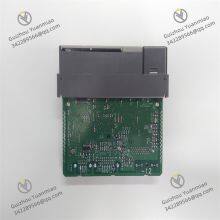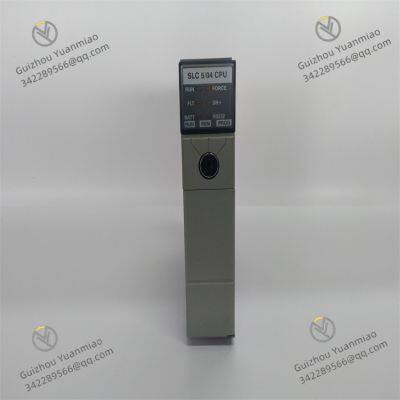Material
Other, Global universal model
Condition
Other, Global universal model
Task
Other, Global universal model
Mathematical Model
Other, Global universal model
Signal
Other, Global universal model
Customized
Non-Customized
Structure
Other, Global universal model
Operating temperature
0°C - 60°C
Humidity
5% - 95% (non - condensing)
Anti-vibration performance
10-55Hz, amplitude 0.38mm
Dimensions
160mm×100mm×150mm
Storage temperature
-40℃-85℃
I. Product Overview
1747-L541 is a high-performance processor module in the SLC 500 series programmable logic controller (PLC) of Allen-Bradley, a brand under Rockwell Automation. As the core of the entire control system, it undertakes key tasks such as logical operation, data processing, instruction execution, and equipment collaborative control. It can receive on-site signals from various input modules, perform arithmetic processing according to preset control programs, and then send control instructions to actuators through output modules to realize automatic control of industrial production processes. With its strong processing capability and stable operation performance, 1747-L541 is widely used in medium-sized industrial automation scenarios, such as automobile parts production lines, chemical reaction device control, logistics transportation system scheduling, etc., providing solid control support for the efficient, accurate and stable operation of industrial production.

II. Functional Features
Strong processing capability: Equipped with a high-performance microprocessor, it has fast instruction execution speed and data processing capability, and can efficiently handle complex tasks such as logical control, timing and counting, and arithmetic operations. For industrial scenarios with a large number of input and output points and complex control logic, such as multi-station collaborative assembly lines, it can ensure the rapid response of control programs, reduce control delays, and improve the coordination of production rhythms.
Rich memory configuration: Equipped with a certain capacity of program memory and data memory (for example, the program memory can reach 32KB, and the data memory can reach 10KB, subject to specific product parameters), which can meet the program storage and data caching needs of medium-sized control projects. It can store complex control algorithms, process parameters, equipment status data, etc., support step-by-step execution of programs and real-time update of data, and provide guarantee for the flexible operation of the control system.
Diverse communication interfaces: Integrating multiple communication interfaces to support data interaction with other devices. For example, it is equipped with an RS-232 serial communication port, which can realize connection with upper computers and human-machine interfaces (HMI), facilitating operators to download, upload, monitor programs and set parameters; it supports accessing industrial networks such as DeviceNet and EtherNet/IP through extended communication modules, realizing networked communication with on-site devices such as sensors, actuators and frequency converters, and building distributed control systems.

Flexible programming support: Compatible with Rockwell Automation's RSLogix 500 programming software, supporting mainstream programming languages such as ladder diagram (LD) and statement list (STL), which is convenient for engineers to write and debug programs according to control requirements. The software provides a rich set of instructions, including logic instructions, timing and counting instructions, data processing instructions, motion control instructions, etc., which can meet diverse control scenarios, reduce programming difficulty and improve development efficiency.
Reliable fault diagnosis and protection: It has a complete self-diagnosis function, which can monitor the operation status of the processor itself, memory usage, communication link status in real time. When detecting abnormalities such as program errors, hardware faults, and communication interruptions, it can trigger alarms in time, and feed back fault information to operators through indicator lights or communication interfaces, facilitating quick location and troubleshooting. At the same time, it supports online modification of programs and fault recovery, reducing system downtime.
Strong expansion capability: As part of the SLC 500 series, it can be flexibly combined with various input modules, output modules, power modules, communication modules of the series, and expand the number of input and output points and functions of the system according to actual control needs. For example, adding analog input and output modules to achieve precise control of process variables such as temperature and pressure, and adding high-speed counting modules to achieve position tracking of high-speed moving equipment, meeting the customized needs of different industrial scenarios.
Industrial-grade stability: Adopting industrial-grade design standards, it has excellent anti-electromagnetic interference capability, temperature resistance and anti-vibration performance, and can operate stably in harsh industrial environments. The working temperature range is usually 0℃-60℃, which can adapt to temperature fluctuations in factory workshops; it has certain dustproof and moisture-proof capabilities to ensure long-term reliable work in dusty and humid environments and guarantee the continuity of production.

III. Technical Parameters
Processor performance:
Instruction execution speed: The typical instruction execution time is at the microsecond level (for example, the execution time of basic logic instructions is about 1.5μs), ensuring quick response to control needs.
Program memory: 32KB (can store user programs, system programs, etc.).
Data memory: 10KB (used to store variables, intermediate data, status flags, etc.).
Supported I/O points: The maximum can be expanded to a certain number (such as 512 digital I/O points, depending on the configuration of extended modules).
Communication parameters:
Serial communication port: 1 RS-232 port, supporting a baud rate range of 1200-115200bit/s, which can be used for programming, monitoring and communication with HMI.
Extended communication: Supports connection with SLC 500 series communication modules through the backplane bus to realize network communication such as DeviceNet and DH-485 (corresponding modules are required).
Power parameters:
Power input: Obtain 5V DC power through the SLC 500 backplane, with a typical current consumption of about 300mA (the specific value is subject to the product manual).
Physical parameters:
Dimensions: Length about 160mm, width about 100mm, height about 150mm (compatible with other modules in the SLC 500 series), suitable for installation in standard racks.
Weight: About 0.7kg, moderate weight, easy to install and maintain.
Environmental parameters:
Working temperature: 0℃-60℃.
Storage temperature: -40℃-85℃.
Relative humidity: 5%-95% (non-condensing).
Anti-vibration performance: 10-55Hz, amplitude 0.38mm.
Impact resistance: Peak acceleration 15g (duration 11ms).

IV. Working Principle
Signal acquisition and input: The 1747-L541 processor module is connected to the input module through the backplane bus of the SLC 500 series, and receives various signals from the site, such as digital signals from limit switches and proximity sensors, analog signals from temperature sensors and pressure transmitters, etc. The input module converts these physical signals into electrical signals recognizable by the processor and transmits them to the processor's data memory.
Program execution and operation: The processor reads the control program written by the user from the program memory and executes instructions in sequence according to the program logic. During execution, it continuously retrieves input signal data, intermediate variables, etc. from the data memory, performs logical judgment, arithmetic operations, timing and counting, etc., and generates corresponding control instructions based on the operation results. For example, in pipeline control, the processor calculates control signals for starting and stopping the conveyor belt and the action of the robotic arm according to the workpiece in-place signal (input) and the preset production rhythm.
Control instruction output: The processor transmits the generated control instructions to the output module through the backplane bus. The output module converts the electrical signals into signals suitable for the actuator (such as relay contact signals, DC voltage signals, etc.) to drive actuators such as solenoid valves, contactors, and motors to act, realizing the control of the production process. At the same time, the processor will store output status, equipment operating parameters and other data into the data memory in real time for subsequent monitoring and analysis.
Communication and interaction: The processor conducts data interaction with upper computers, HMI, other PLCs and other devices through built-in communication interfaces or extended communication modules. It sends equipment operating status, fault information and other data to the upper computer, and receives control parameter modification instructions from the upper computer; exchanges data with HMI to realize visual display of production data and instruction input by operators; in distributed control systems, it works with other processors to share control information and realize global coordinated control.
Fault monitoring and handling: During the entire working process, the processor continuously performs self-diagnosis and monitors the status of external equipment. If program errors (such as logical conflicts, stack overflow), hardware faults (such as memory errors, communication interface faults) or abnormal external equipment (such as sensor disconnection, actuator faults) are detected, it will immediately trigger an internal alarm mechanism, light up the corresponding fault indicator, and store the fault code and related information in the data memory. At the same time, corresponding measures can be taken according to the preset fault handling program, such as stopping the operation of some non-critical equipment and starting standby equipment, to prevent the expansion of faults and ensure system safety.
















































